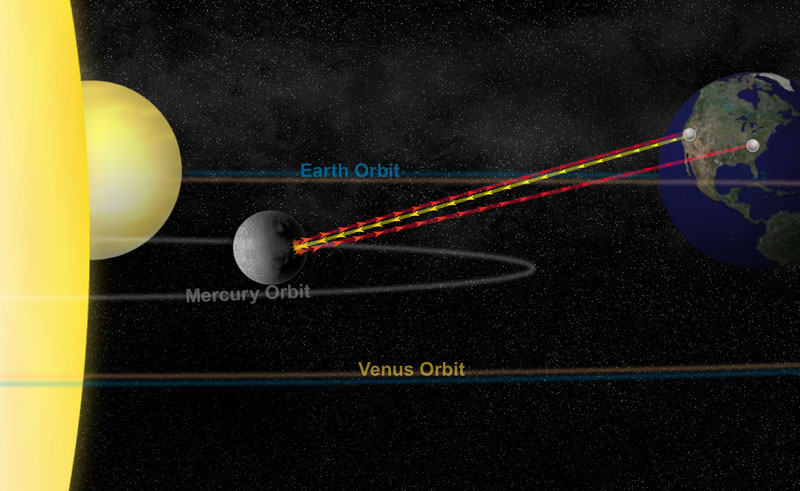The orbit of Mercury is the most eccentric of the planets in our Solar System. The planet has an orbital period of 87.969 Earth days. At perihelion it is 46,001,200 km from the Sun and at aphelion it is 69,816,900 km, a difference of 23,815,700 km giving it an eccentricity of 0.21. Mercury’s orbit is inclined by 7 degrees to Earth’s ecliptic. Mercury can only be seen crossing the face of the Sun when the planet is crossing the plane of the ecliptic and is between the sun and Earth. This happens about once every seven years.
While scientists have long known the orbital period of Mercury, they were wrong about its rotational period. Until the 1960s the prevailing theory held that the planet was tidally locked to the Sun and did not rotate at all. That was because when it was in a prime position for observation, the same portion of the planet was always visible. It wasn’t until 1965 that US astronomers, using the Arecibo Observatory, would prove conclusively that the planet’s rotational period was about 59 sidereal days. There is a direct correlation between the orbital period and rotational period. This is called spin-orbit resonance. For every 2 orbits of Mercury around the Sun, it rotates three times on its axis. This is known as a 3:2 spin-orbit resonance.
Despite the slow rotational period, Mercury does have a global magnetic field and both Mariner 10 and MESSENGER indicate that the strength and shape of the magnetic field are stable. Measurements taken by Mariner 10 led scientists to estimate that it is about 1.1% of the strength of Earth’s. Mercury’s magnetic field is dipolar and most likely generated by a dynamo effect. This dynamo effect would result from the circulation of the planet’s iron-rich liquid core. Mercury’s magnetic field deflects the solar wind creating a magnetosphere. The magnetosphere is strong enough to trap solar wind plasma contributing to the weathering of the surface. The Mariner 10 spacecraft detected this low energy plasma in the magnetosphere of the planet’s night side.
As you can see from this article, scientists know a great deal about the orbit of Mercury, but there are still things being discovered and waiting to be discovered. Mariner 10 provided a wealth of information, but left an incomplete picture. MESSENGER will fill in the blanks a little more and there is no limit on what may be revealed in the coming year.
We have written many articles about Mercury for Universe Today. Here’s an article about the rotation of Mercury, and here’s an article about the transit of Mercury.
If you’d like more information on Mercury, check out NASA’s Solar System Exploration Guide, and here’s a link to NASA’s MESSENGER Misson Page.
We’ve also recorded an entire episode of Astronomy Cast all about Mercury. Listen here, Episode 49: Mercury.
References:
NASA Solar System Exploration: Mercury
Wikipedia
NASA: Mariner 10
NASA: MESSENGER Spacecraft

